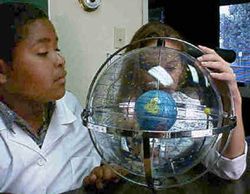BACKGROUND:
The Universe is a vast space of unknown dimensions.
The Milky Way is our address in the Universe. Our Sun is only one small
component amongst the other billions of stars in our galaxy, the Milky Way.
The Solar System is a group of 9 planets that revolve around the Sun.
We see objects in the night sky because they are
either generating or reflecting light. While these objects also shine or
reflect light during the day, we generally cannot see them because they are
much dimmer than the bright light emitted by the nearby Sun.
Most of the light we see at night comes from within
our own galaxy, the Milky Way. Some points of light, however, are from other
galaxies or nebulas, which are glowing clouds of gas within our galaxy.
Most of the stars and galaxies we see at night are
very far away. This is difficult for humans to comprehend. We do not even
measure the distance in kilometers; instead, we use light years. Light
travels about 300,000 km per second, faster than anything we know.
A light year is the distance light can travel in one year, an almost
unimaginable number. Multiply the number of seconds in one year (31,557,000)
times 300,000 km/yr. This results in a distance of 9,467,100,000,000 km per
year, or about 9.5 quadrillion kilometers/year.
When ancient people looked in the night sky, they
noticed groups of stars which formed images of animals, gods, and heroes. In
the silence and darkness, ancient humans started to tell stories to one
another for entertainment. The students will look at two constellations in
the lab: Orion and the Big Dipper.
Orion was a hunter who was killed by a giant scorpion.
He was placed in the sky but was still chased by the scorpion, which is
found in a constellation (Scorpio) on the other side of the sky. When Orion
is visible, the scorpion is below the horizon. When the scorpion rises,
Orion sets, so that they are never visible at the same time. The Big Dipper
is actually part of the Ursa Major (Big Bear) constellation, and represents
a cup with a long handle.
These points of light in the sky, and the shapes they
represented, were also important for traveling at night and for determining
the time of the year. The constellations, as they are now called, helped to
guide the early people in many ways.
The constellations are groupings of points of light,
as seen from the Earth. Some of the points of light may represent far away
galaxies, but the majority represent individual stars. There are 88
constellations that have been part of a historical written record. There are
many other cultures who had terms for patterns of light, but unfortunately
their record was not passed on through generations like the European/North
African stories. These constellations will help students orient themselves
in the nighttime sky.
PROCEDURE:
 Show students a celestial globe or a picture of the night sky. In the
celestial globe the Earth is in the center. Tell students that if they
are standing on the Earth and looking up they will see the stars on the
other clear globe. If you are standing in the United States the stars
you see in the sky are different than if you are standing on Australia.
There is many directions to the Universe, depending on where you are
looking.
Show students a celestial globe or a picture of the night sky. In the
celestial globe the Earth is in the center. Tell students that if they
are standing on the Earth and looking up they will see the stars on the
other clear globe. If you are standing in the United States the stars
you see in the sky are different than if you are standing on Australia.
There is many directions to the Universe, depending on where you are
looking.
- Tell the students that we cannot see all the points of light of the
night sky that are shown in many books (as shown the Glow in the Dark
Night Sky Book) because of city lights and haze. Ask the students to
name things that they may see in the night sky (moon, stars, satellites,
planets, and galaxies). Explain that only stars and galaxies shine, or
emit light; the other sky objects all reflect light.
- You may want to ask students, how fast does light travel? They may
never have thought about this question before. Switch the light on and
off and ask them how long it takes the light to move from the bulb to
the ground. Students won't be able to time such an event. Explain the
speed of light and light years. You may want to compare the speed of
light with the speed of a car on the freeway which is about 80 km per
hour or 1.33 km per minute or .02 km per second. Light is fast!
- Ask the students which objects make their own light. Stars generate
light because they are giving off energy. Ask them which star is closest
to us. If they do not know, explain that it is our own Sun. Tell them
that stars are like our Sun, but very far away. Show pictures of
different types of stars, and say that our Sun is only a medium size
star.
- Explain that patterns of stars are called constellations, and that
there are stories about some of these groups. Astronomers now use 88
constellations to help divide the Universe into areas. Scientists use
these to help locate components in that sector. So the term
constellations can mean a historical grouping of stars with stories and
myths associated with them, or as a way to locate an area on a Celestial
Globe.
- Have the students read, "The Big Dipper."